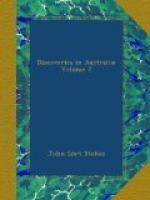Proceeding, we crossed the bar, extending three quarters of a mile off the mouth of the inlet, on which we found only two feet at low-water. The coast on each side was sandy, with clumps of trees, and to the northward was fronted by an extensive flat of sand. The first reaches of the inlet promised well, having a depth of from 1 1/2 to 3 fathoms, and a width of from two to three hundred yards; but it ultimately became much narrower, and so torturous that, after following its windings for twenty-seven miles, we had only advanced eight miles in a South 60 degrees East direction from the entrance. It then divided—one branch trending south, and the other east; and each being only fifteen yards wide and two feet deep, the water quite salt, and the mangroves on either side, moreover, almost meeting, rendered it impossible to proceed further. Our hopes had been buoyed up as we advanced, an impression prevailing that we had discovered a river, from our finding that at low tide the water was simply brackish. I can only account for this by supposing that there was an imperceptible drainage of fresh water through the banks.
The highest part of the country we saw was on the south side of one of the reaches, six miles from the mouth; but even there the utmost elevation was only ten feet. This rise was marked by a growth of tolerable-sized eucalypti. Elsewhere the banks were scarcely three feet above high-water level, and generally fringed with mangroves, behind which in many places were extensive clear flats, reaching occasionally the sides of the inlet towards the upper parts, and forming at that time the resort of large flights of the bronze-winged pigeon.
In many of the reaches we met with flocks of wild ducks, of the white and brown, and also of the whistling kind. The birds we had not before seen were a large dark brown species of rail, so wary that I could never get within shot of it, and a rather small blackbird with a white crest. A few of the large species of crane, called the Native Companion, were also seen. The only kind of fish taken was the common catfish.
PARTY OF NATIVES.
Alligators were very numerous for the first fifteen miles as we ascended; and we saw a party of natives, but did not communicate with them. Their astonishment at the appearance of such strange beings as ourselves must have been very great. It could never before have fallen to their lot to behold any of the white race; and until our presence undeceived them, they must have been living in happy ignorance that they were not the only specimens of humanity upon the face of the earth.




